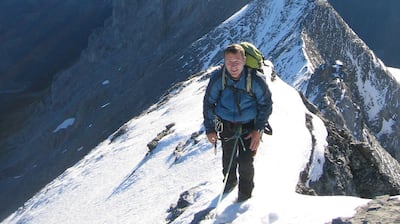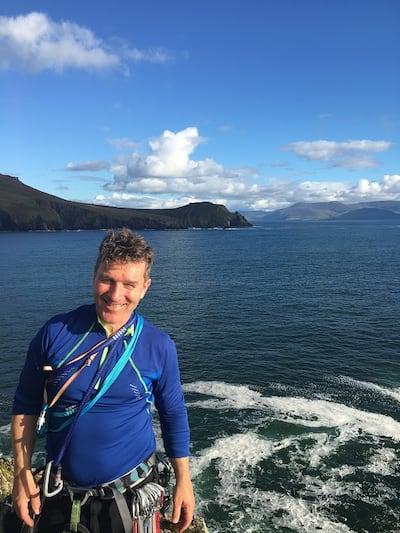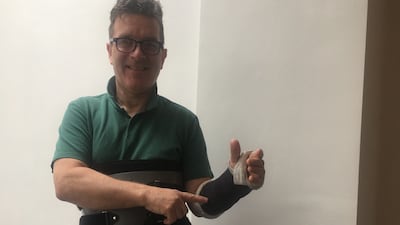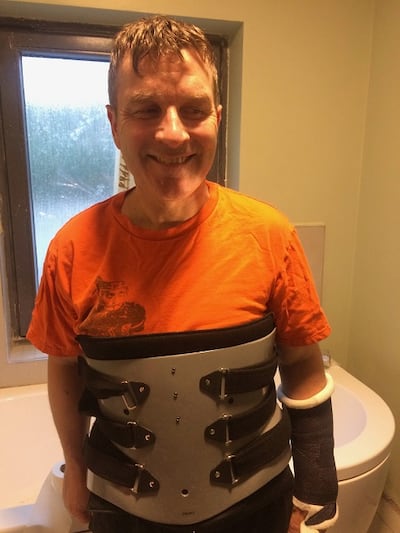I know where I should start this story but it’s so hard to start it from there.
It is not during my transfer by ambulance from St Vincent's Hospital to the Mater Hospital in the dead of night, trying to guess what part of the city we are passing from the lights coming in through the roof window.
It’s not when I am being moved a day earlier from a bed to a stretcher for a scan and the medics are doing a “log roll” to protect my back.
I try to accommodate them by playing a horizontal statue, As they roll my supine body to the left and then to the right, it I’m saying (to myself): “I hope I’m not going to end up in a wheelchair.”
As they are doing it, some are talking about looking forward to that night's instalment of Love Island.
In real life, the profound and the banal coexist side by side.
Where I should start the story is earlier, a few days earlier.
From the moment I realised I’d had a bad fall and really hurt myself, I adopted a really positive attitude, refused to feel sorry about it. Okay, I knew I had broken bones but I was lucky and had no one to blame but myself. It wasn’t that I was being brave or selfless. I knew the consequences of what happened could have been far far worse.

That positive mindset involved only one artifice and that was not thinking about the actual mechanics of the accident, or the run-up to it.
It wasn’t denial.
I knew from the first day that it would be excruciatingly painful to recall, and even more tortuous to write about it. Because with every sentence describing every move, I would cringe and grimace at the stupid mistakes I made.
In truth, in the five months since it occurred I have consciously avoided considering that fateful moment.
Until now.
So here is how it started.
It happened in Dalkey Quarry in south Dublin, the go-to spot for rock climbers in Dublin. It's an old granite quarry dating from the 19th century, the rocks of which built Dún Laoghaire harbour and much else. A mini train track – the metals – ran all the way from the quarry to the shore.
What has been left after the miners left is a series of impressive and imposing cliffs over two levels, that overlook Dublin Bay.
The quarry itself slowly went back to nature. Mature trees, thick bushes and abundant wildlife fills its valleys. Of course, the cliffs were made by man and there are other traces too – cylindrical holes where the dynamite was placed. And over the last century you see small traces of a different human activity on the cliffs – rusted pitons hammered into cracks, various pieces of tattered rope or abandoned gear high up on a climb.
Early on a Thursday morning in late June, I went climbing with another Irish Mountaineering Club member in the quarry. It was a day from heaven, blue skies, a view of Dublin Bay that was borrowed from the Mediterranean, placid seas, boats and ships gliding tranquilly.
I tackled Tramp. It was my second “lead” climb of the day, having done a climb called Jameson 10 a little earlier. I had done my first climb easily, a little too easily, and my confidence was a little higher than it should have been.
Many mistakes
And so to the many mistakes. The first was I knew little about the climb other than seeing another club member climb it a year before. The second was I started it without doing a proper recce (reconnaissance: figuring out the moves from the ground). The third was that I put in only one piece of protective gear before reaching the crux, which was a convex corner, with a crack in the rock running up vertically. It turned out to be useless when the fall happened.
Although I managed to get the protective camming device into the crack, I just could not get the rope up into the carabiner. It was really warm and the rock seemed like it was sweating and suddenly the purchase I had on my hold was slipping.
My next mistake was that I panicked. I remember a series that Irish Times colleague Peter Murtagh wrote about the Irish army rangers training ahead of a mission to Mali. They did the same exercises over and over again, so when such an emergency occurred in real life, they would be able to able to use their muscle memory to respond.
I should not have got into that situation in the first place, but when I did I should have been able to focus, to remain cool and not panic
I should not have got into that situation in the first place, but when I did I should have been able to focus, to remain cool and not panic.
It was a fail on all three counts.
There were things I could have done, including holding on to the piece of gear or trying to retreat, but I did none of those things. I could feel myself slipping.
And then I was gone.
People ask you what goes through your mind when you are falling. The answer is nothing. Truth is, it happens so quickly that your next conscious moment is picking yourself up from the ground.
My fall was between three and four metres and, luckily, on to grass, hardened by a dry June. I’m not sure what happened to my first piece of gear, a nut. It had become dislodged either while I was climbing up, or else wasn’t as secure as I had thought. Or else the slack rope in my hand was so long that the first piece of protection had become redundant.

When I decked, I immediately felt the pain in my wrist and the general all-over pain of being winded and bruised.
And there followed another major mistake. I moved. I should have stayed put, but instinct and adrenaline kicked in. I knew I had broken my left wrist, as that was very painful.
But I had also broken my back, though I did not realise it at the time.
The wrist at the time seemed the problem, but it was only part of the problem.
So I got up and walked to a car. Even as I walked to the car, I could feel how sore my lower back was. It was when I was in the car that I realised that my back could also be an issue. The nearest hospital was Loughlinstown. By the time I got there, I was not able to sit down and stood in the waiting room in some pain. They told me they could treat my wrist but not my back so it was back into the car and on to St Vincent's Hospital.
I can’t remember how long I was waiting in St Vincent’s but it seemed forever. I stood in the waiting room and, once through into the department, I stood outside the treatment room, trying to lean against a wall.
Treated for shock
It was only when the consultant looked at me that I was placed immediately on a trolley, and also treated for shock (my blood pressure had fallen sharply).
So all of that movement was a mega mistake. With a broken back, especially if there was a danger of spinal cord damage, that could have been very grave. The cardinal rule for somebody who has fallen is don’t move.
Once on the trolley, I lay on my back for four days, not allowed to move. My only view of the world was an upward one, mainly of ceilings and lights spinning by as I was being wheeled from one place to another for an interminable series of checks. Although not wearing a brace, I was still obviously a spinal risk. I encountered more log rolls over that time than a Canadian lumberjack in felling season.
Once over the A&E bottleneck, my experience of Irish healthcare could not have been more positive. A battery of X-rays and scans, including an MRI, confirmed a really bad break in the wrist as well as an unstable fracture in my lower back (lumbar) region.
From early on, I knew I needed surgery on the wrist. The top of the radius had been smashed so I needed a plate inserted. The only question now was about my back. The scans were sent to the National Spinal Unit in the Mater Hospital. Very late on Friday night, I was told I was being transferred there as surgery would be required. When they called Fiona at home she was very upset (as was our daughter, Sadhbh), fearing the worst.
I had been sanguine up until now. I had no pins and needles on my limbs. I had suffered no head injury. I could wiggle all my fingers and toes. Still, doubts crept in.
When you have been fit and healthy all your life, it is a very unreal experience being in a hospital setting. You become helpless, like a discarded toy, completely dependent on others, unable to go to the toilet, unable to do anything for yourself.
The most unreal part was the journey and arrival at the Mater. The ambulance arrived after 2am. It was a Friday night and they had to deal with ambulance rush hour. I was log-rolled onto the gurney and then braced and wrapped as tightly as an Egyptian mummy. As we sped through the city, the paramedic said he’d already taken a number of people from Dalkey Quarry that summer. A few days later, a nurse in the Spinal Unit said the same thing. And when I thought about it, I could think of four or five climbers who had sustained bad breakages in the past year. It was a sober reminder of the dangers of the sport – that you should never become blasé or take anything for granted.

The National Spinal Unit in the Mater is small and modern, with about a dozen beds, and amazingly dedicated and caring staff, who witness the heart-breaking consequences of catastrophic injuries on a regular basis.
I landed there at 4am on Saturday. The room I went into was plain. It looked like an operating theatre, an impression buttressed by the serious-looking equipment surrounding the bed, including a TV screen attached to a pivoting arm.
Pin and brush test
A medic did the pin and brush test, which was unnerving. They pricked the skin with a pin, and then brushed the skin gently, to ascertain my sense of feeling. Thankfully, it was okay. Early the next morning, the registrar came in to tell me the results of the scan. I would probably need an operation on the back, and definitely on the wrist. The good news was there was no damage to the spinal cord. For the first time since the accident I cried, tears of relief.
Things moved quickly. That evening I was wheeled into theatre at about 7pm. The consultant orthopaedic surgeon was Michael Dodds, originally from Sheffield. He's a very likeable guy, low-key and positive. He did the back surgery (a fusion involving a pin) and then flipped me over to operate on the wrist – it needed a plate and loads of screws. He had to put bits of bone back to rebuild the top of the radius: it looked like the inside of a Crunchie Bar, he said . . . All in all it took until 2am, six or seven hours in the depth of a weekend night.
I woke the following day, feeling groggy after the operation and the painkillers. All I could do really was look at the drawn game between Galway and Kilkenny on television. I braced myself for a long stay.
It wasn’t to be. The next morning the plaster specialists came up to put my left arm in a cast and to fit me with a brace around my lower waist. It essentially looks like a plastic piece of armour – if you are thinking superhero, it is definitely Turtleman. Within minutes, a physiotherapist had arrived and I was walking up and down the ward with this strange shell around my waist.

They didn’t hang around.
I spent Monday walking up and down the ward.
I was tested on a stairs on Tuesday and discharged Wednesday morning.
I stopped using all painkillers the following Sunday.
It made for an alternative summer. As a naturally highly-strung and intense person, I had to learn the virtues of patience. With an arm in plaster and wearing a brace, everything was done at snail’s pace. But I settled into the pace. I got out for a walk most days, learned how to cook with a hand in plaster, and got to appreciate the joys of daytime TV.
Originally, I was to wear the brace night and day for 12 weeks but after a few weeks, I was allowed to take it off at night (which made a huge difference). I had never seen a brace before that but every time I visited the outpatients I met plenty of members of my new brace-wearing species – one guy had broken his back when diving in Sandycove, another had slipped awkwardly on kitchen tiles.
And so to recovery, which has progressed well. Now in mid winter, I'm cycling, swimming and taking long walks with short run intervals. I'm only about six weeks away from going back running continuously. Both wrist and back are recovering well (though there's still a bit to go), thanks to an exacting regime set out by physiotherapist Doireann Murtagh.
I have learned plenty of personal lessons. My abiding thought from the moment it happened was that I was steeped in luck. Maybe that was the reason I remained very positive from the moment it happened. And so, I can treat any lingering niggles from the accident like a dent on the bodywork of an ageing car: a little rusty but the engine is still going.
At least I know where my story will end.
Essentially, it closes with another recurring question I have been constantly asked since the accident:” You’re surely not going back rock climbing again, are you?”
The answer to that one is, for the moment, ambivalent.











